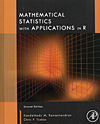- About MAA
- Membership
- MAA Publications
- Periodicals
- Blogs
- MAA Book Series
- MAA Press (an imprint of the AMS)
- MAA Notes
- MAA Reviews
- Mathematical Communication
- Information for Libraries
- Author Resources
- Advertise with MAA
- Meetings
- Competitions
- Programs
- Communities
- MAA Sections
- SIGMAA
- MAA Connect
- Students
- MAA Awards
- Awards Booklets
- Writing Awards
- Teaching Awards
- Service Awards
- Research Awards
- Lecture Awards
- Putnam Competition Individual and Team Winners
- D. E. Shaw Group AMC 8 Awards & Certificates
- Maryam Mirzakhani AMC 10 A Awards & Certificates
- Two Sigma AMC 10 B Awards & Certificates
- Jane Street AMC 12 A Awards & Certificates
- Akamai AMC 12 B Awards & Certificates
- High School Teachers
- News
You are here
Mathematical Statistics with Applications in R

Publisher:
Academic Press
Publication Date:
2014
Number of Pages:
826
Format:
Hardcover
Edition:
2
Price:
150.00
ISBN:
9780124171138
Category:
Textbook
[Reviewed by , on ]
Jennifer L. Sinclair
06/26/2015
Mathematical Statistics with Applications in R is intended as a textbook for use in a one or two semester course on probability and statistics, a course which is titled Mathematical Statistics at some institutions. A student is prepared to utilize this text after completing basic level calculus; knowledge of multidimensional calculus is not prerequisite material.
Lately, there has been an effort to fast track students to graduate level mathematics, whilst skimming over the underpinnings. The text is a counterexample to this trend. It is primarily indicated as an upper level undergraduate mathematical statistics textbook, but could also be used as a worthy statistics reference book for a mathematician’s bookshelf. It tries to engage students in conducting statistical analysis earlier in the curriculum than traditional textbooks on mathematical statistics. This may be of particular interest for interdisciplinary students, applied students, and students interested in industry occupations. It may be of supplemental use to a student entering a traditional proof-intensive program in mathematics. The book is mathematically rigorous, but takes an applied-student-friendly point of view on the traditional content.
Historically, mathematical statistics courses focus on probability in the fall semester and statistics in the spring semester. This text spends a brief few chapters on probability and engages students with statistical procedures by the middle of the first semester. Chapters 2–3 cover probability, with chapters 5–6 introducing statistical estimation and basic hypothesis testing. Linear regression, analysis of variance, and even nonparametric tests are explored (this list is not meant to be an exhaustive list of all topics covered in the book). Exercises and project ideas are present in each chapter. Solutions to selected exercises are available to the student, as solutions to a majority exercises are available to the professor on the instructor companion website.
The layout may present an obstacle for instructors required to teach mathematical statistics incorporating multidimensional calculus. It is not unusual for a course catalog to precisely mention the use of multidimensional calculus as a hallmark of a mathematical statistics course (as opposed to an elementary statistics course). In this case, the instructor must supplement multi-dimensional material.
The effort to implement R, SAS, SPSS, and Minitab is highly appreciated. Oftentimes, instructors are left to search the internet for instructions and project ideas regarding technology use. The text offers clear technology instructions, yet does not go into too much detail in order to account for different versions of the software. This is a positive characteristic, as the emphasis lies on understanding the big picture ideas of technology usage, rather than overly detailed line-by-line instructions that hinder intuition and quickly go out of date. Computer examples appear at the end of each chapter as a separate section.
One can appreciate the readability of the formatting, including compact font size and horizontal lines separating topics, common in lower level textbooks but often missing from upper level textbooks. A few spot errors are common in a large text of this magnitude and seem minimal. The text has been classroom tested and is on its second edition. This book is highly recommended for use as the primary textbook for an undergraduate mathematical statistics course in a mathematics or statistics department.
Jennifer Sinclair is an associate professor of mathematics at Georgia Gwinnett College. Additional information is available at http://www.ggc.edu/about-ggc/directory/jennifer-sinclair.
Chapter 1 - Descriptive Statistics
Chapter 2 - Basic Concepts from Probability Theory
Chapter 3 – Additional Topics in Probability
Chapter 4 – Sampling Distributions
Chapter 5 – Statistical Estimation
Chapter 6 – Hypothesis Testing
Chapter 7 – Goodness-of-Fit Tests Applications
Chapter 8 – Linear Regression Models
Chapter 9 – Design of Experiments
Chapter 10 – Analysis of Variance
Chapter 11 – Bayesian Estimation Inference
Chapter 12 – Nonparametric Tests
Chapter 13 – Empirical Methods
Chapter 14 – Some Issues in Statistical Applications: An Overview
- Log in to post comments




